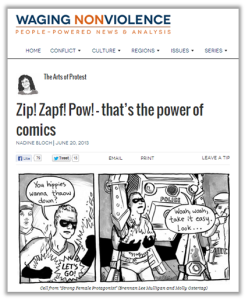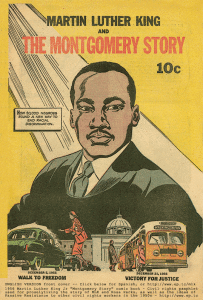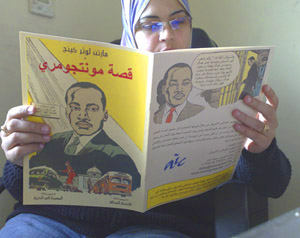Nonviolence Currents – Bridging Nonviolence and Current Events in the Classroom
A service of the Metta Center for Nonviolence
LESSON PLAN #5
 Waging Nonviolence Article: Zip! Zapf! Pow! – that’s the power of comics by Nadine Bloch
Waging Nonviolence Article: Zip! Zapf! Pow! – that’s the power of comics by Nadine Bloch
Themes: Activism, art, media literacy
Target age group: Ages 14 & up
Subject areas: Art, English Language Arts, Social Studies
Pre-reading vocabulary check: Ask students to skim the article and look up unfamiliar words.
Pre-reading discussion:
-
Do you read any comics? Which ones? Why?
-
What themes or storylines are portrayed in these comics?
-
Discuss the characters in the comics. What qualities do they portray? What are their strengths and weaknesses?
-
Who is the audience that this comic is intended for?
-
-
What makes a comic book effective? What are some techniques or skills for good comic-strip story telling/illustration?
-
Have you seen many comics with nonviolent heroes? What would a nonviolent hero do differently than a violent hero?
-
What is the unquestioned narrative about violence and justice in violent comics (e.g. good guys/bad guys, etc.)? What counter-narrative would you find in a nonviolent comic book?
Reading: Set aside time in class to read the article (10-15 minutes) or assign the reading for homework the night before class.
Post-reading discussion:
-
Why is the medium of comics an effective way to portray a message of nonviolence?
-
Why might comics be particularly effective at raising awareness about peace, nonviolence, and social justice issues?
Activity 1: The Montgomery Story
Have students read the Martin Luther King comic book published by the Fellowship of Reconciliation, recently re-made popular during the events of “Arab Spring.”
Discuss what students learned about nonviolence from reading this comic.
Activity 2: Research
In small groups, have students research any comic with themes of peace, nonviolence, social justice, and activism (such as the ones suggested in the article: Strong Female Protagonist, The Montgomery Story, Adventures of Unemployed Man, Persepolis – or research and find your own!).
Then have each group report back to the class on the comic that they chose. After students present, discuss the similarities and differences between the comics (storylines, characters, themes, etc.).
Activity 3: Make Your Own Comic
Individually or with a partner, have students create their own comic on an issue that is important to them (examples: bullying, school violence, pollution, global warming).
1. Students choose a theme or story that they want to tell through their comic. Ask:
-
What issue is important to me that I want to tell through my comic?
-
Who is my audience?
2. Next, students should decide on the purpose or goal of their comic. For example, the author of the article talks about how comics can:
-
tell a story
-
teach a lesson
-
illustrate why you are struggling or the issues that you face

-
garner public support
-
get your message out
3. Now your students are ready to create the comic. If students work in pairs, they can collaborate to write the storyline and draw the pictures.
4. Have students share their comics. Depending on the medium you use, you could have students post the comics on the wall and do a “gallery walk” through the classroom. Alternatively, you could have students present their comics to the class. Also consider creating a web page to post the comics to showcase them to the rest of the school and wider community, or creating a zine to showcase all the comics.
Lesson plan created and developed by Stephanie Knox Cubbon and Stephanie Van Hook of the Metta Center for Nonviolence.
If you have any questions about this lesson, or if you use it and would like to tell us about it, please write to use at education@mettacenter.org. We would love to hear from you!








